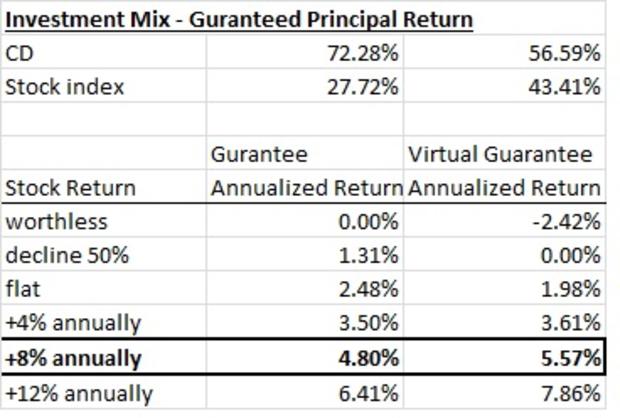How to invest in stocks without risk in 2014
For those who don't think it's possible to invest in stocks and still be assured of getting your principal back, think again. In fact, it can be done with an average expense ratio of 0.02 percent annually, along with high tax-efficiency, and all guaranteed by the U.S. government.
Here are a couple of strategies, both employing what I call a "build your own annuity" approach. The approach involves a mix of a long-term risk-free certificates of deposit (CD) backed by the FDIC and a low cost stock index fund such as the Vanguard Total Stock Index ETF (VTI). To illustrate how this works, I'll use a $10,000 investment for all examples. Feel free to add or delete a digit or two.
As of December 27, 2013, Fidelity.com showed the highest ten-year non-callable CD was paying 3.30 percent annually. This means that a deposit of $7,228 will grow to $10,000 in ten years. Take the remaining $2,772 and buy the stock index fund. In this way, you'll have a U.S. government guarantee to get your money back in ten years. More importantly, if stocks turn in an eight percent annualized return, your portfolio will be worth nearly $16,000 in ten years, amounting to a 4.80 percent annual return.
It's reasonable to assume that one could do even better by taking a little risk. Let's face it, if stocks are worthless in ten years, that would be a pretty good indicator that capitalism has failed and taken the U.S. government along with it. So if we presuppose that the worst total return stocks would turn in over a decade is a 50 percent loss, you could invest a greater proportion in the stock index fund. Putting this in perspective, the S&P 500 would have to lose about 60 percent for the total return (which includes dividends) to lose half its value.
This allows a $5,659 investment in the CD and a $4,341 investment in the stock index fund. If stocks do become worthless, you are left with only $7,829 in the CD and a loss of $2,181, but money is probably worthless in this scenario anyway. On the other hand, if stocks lose 50 percent, you get your full $10,000 back. An eight percent annualized return for stocks yields a total portfolio annualized return of 5.57 percent, making your portfolio worth over $17,200. Other scenarios are shown in the chart.
Perhaps the biggest advantage this strategy has is emotional. When stocks tank, knowing that the total principal is guaranteed up to FDIC limits may give investors the strength not to panic.
